
Panhard was a French motor vehicle manufacturer that began as one of the first makers of automobiles. It was a manufacturer of light tactical and military vehicles. Its final incarnation, now owned by Renault Trucks Defense, was formed by the acquisition of Panhard by Auverland in 2005, and then by Renault in 2012. In 2018 Renault Trucks Defense, ACMAT and Panhard combined under a single brand, Arquus.

De Dion-Bouton was a French automobile manufacturer and railcar manufacturer operating from 1883 to 1953. The company was founded by the Marquis Jules-Albert de Dion, Georges Bouton, and Bouton's brother-in-law Charles Trépardoux.

The Renault Caravelle is a sports car manufactured and marketed by Renault for model years 1958–1968 in a single generation — as a rear-engine, rear-drive open two/four-seater designed by Pietro Frua of Carrozzeria Ghia, using the floorpan and engine of the Renault Dauphine.
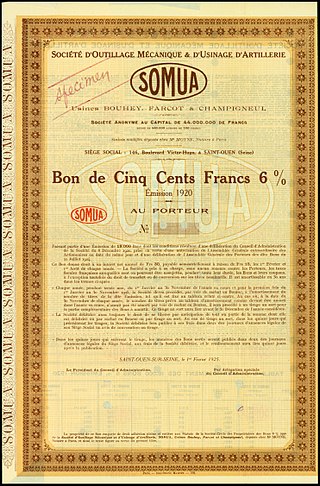
Somua, an acronym for Société d'outillage mécanique et d'usinage d'artillerie, was a French company that manufactured machinery and vehicles. A subsidiary of Schneider-Creusot, Somua was based in Saint-Ouen, a suburb of Paris.

Chemins de fer de la Corse (CFC) is the name of the regional rail network serving the French island of Corsica. It is centred on the town of Ponte Leccia, from which three main lines radiate to Ajaccio, Bastia, and Calvi. The section following the northwest coastline between L'Île-Rousse and Calvi, known as the Balagne line, gives access to many beaches and is very popular with tourists.

The Renault NN, generally known to contemporaries simply as the Renault 6 CV, is a compact car or small family car manufactured by Renault from 1924 until 1930.
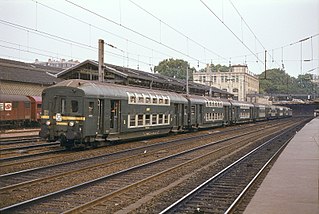
The Voiture État à deux étages,, were a class of double-deck carriages built for Paris suburban services of the French Chemin de fer de l'État.
The Réseau Breton (RB) is a 1,435 mm, standard gauge, and former 1,000 mm, metre gauge, railway in Finistère, France, with a few kilometres of line in Côtes d'Armor, Ille-et-Vilaine and Morbihan. The hub of the system was Carhaix. The metre gauge lines were built with the capacity to be easily converted to standard gauge if necessary.
The Heilmann locomotives were a series of three experimental steam-electric locomotives produced in the 1890s for the French Chemins de Fer de l'Ouest. A prototype was built in 1894 and two larger locomotives were built in 1897. These locomotives used electric transmission, much like later-popular diesel-electric locomotives and various other self powered locomotives.

The Renault Nervasport was a straight-eight engined sporting luxury automobile introduced by Renault in March 1932 and produced until 1935. It was based on the larger and heavier Nervastella. A more streamlined version called the Nerva Grand Sport appeared in 1935 and replaced the Nervasport, remaining in production until the summer of 1937. As with many Renaults during the 1930s, type changes as well as small often cosmetic facelifts and upgrades appeared frequently.

The SNCF X 3800 class are diesel railcars with an elevated off-center control cabin. It is often said that they were nicknamed “Picassos” because the off-center cabin was reminiscent of paintings by Pablo Picasso featuring faces where the eyes and nose were completely offset. The nickname may though have come from the number of early paint schemes applied to the class.

The Renault 2,500 kg and the Renault Galion were truck/vans with a 2.5-tonne carrying capacity manufactured by Renault between 1947 and 1957 and then by its subsidiary Saviem between 1957 and 1965.
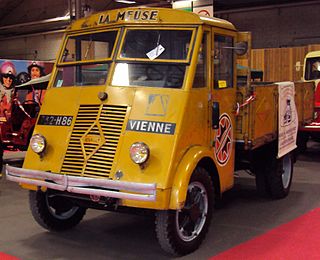
The Renault AHx was a range of light/medium trucks with carrying capacities from 2 to 5 tonnes manufactured by Renault between 1941 and 1947. Various versions were used in World War II by the German forces.
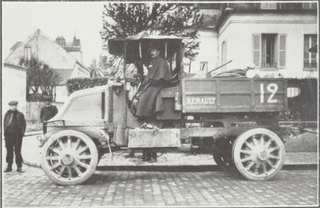
The Renault EG is an all-wheel drive truck/artillery tractor produced between 1914 and 1919 by the French manufacturer Renault.
The Renault AGx was a range of light/medium/heavy trucks produced by the French manufacturer Renault between 1937 and 1941. The range includes both conventional and forward control trucks.

The Renault ACx and ADx is a range of light/medium trucks produced by the French manufacturer Renault between 1935 and 1940. From the range derived some buses.

The Renault TN is a range of buses produced from 1931 until 1971 for the Paris service. They have been described by Le Monde as a "symbol of a Paris era".

SNCF 232.P.1 was an experimental prototype high-pressure steam locomotive ordered by the Chemins de fer du Nord, but delivered to the Société nationale des chemins de fer français (SNCF) in 1939. It was the first and only member of SNCF's first class of 4-6-4 or Hudson type of locomotives.
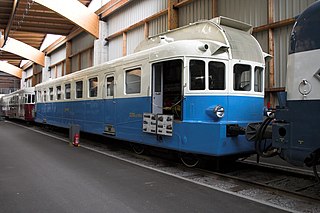
Renault VH is the first standard-gauge railcar produced by Renault in large numbers, starting in 1933. One hundred units were manufactured in the Ile Seguin factories near Paris. The units ran on various SNCF lines until 1970. Two examples have been preserved; one at Cité du Train, the other at Train à vapeur des Cévennes (CITEV).

The Renault ABx is a range of medium-duty forward control trucks produced by Renault between 1934 and 1937. The range was made of the ABF and the ABG. Renault also developed a bus/coach called the ZP using the same cabin.

















